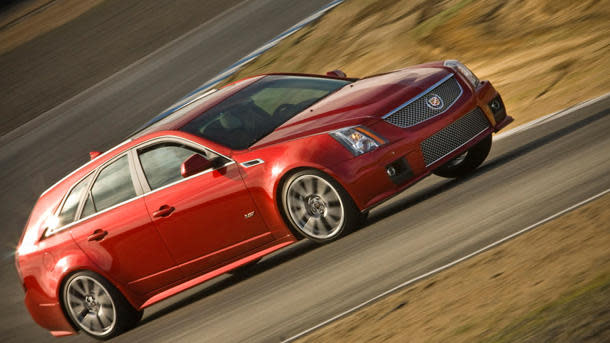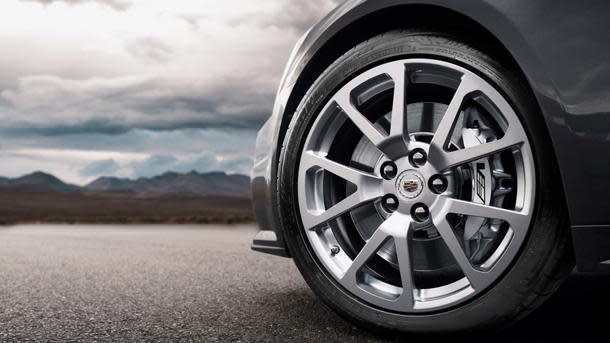 Motoramic
MotoramicInside the Cadillac Performance Academy turning V-Series owners into drivers
The downside of owning a machine like the 556-hp Cadillac CTS-V lies in finding a place to push its limits. You can't drag race in tag teams, run 100 mph or even develop the skill to slide it through a corner — unless you find yourself one early morning at the Cadillac V-Series Performance Academy at Mountain Motorsports Ranch in Pahrump, Nevada. Like I did.
Following the footsteps of Audi, BMW and Mercedes-Benz and their respective driving schools , Cadillac started the V-Series Performance Academy three years ago to provide driving enthusiasts with tips while burnishing the performance cred of the Cadillac CTS-V coupe, sedan, and wagon. The rear-wheel-drive CTS-V is essentially a luxury, five-passenger Corvette ZR1; both cars share a 6.2 liter supercharged V-8 engine and racing-derived upgrades.. Producing 556 hp and 551 ft-lbs of torque, it thunders from 0-60 mph in 4.0 seconds, and tops out at 198 mph. This car means business.
Before you can turn the wheel at speed, Don Harple, Cadillac's performance driving director, delivers a classroom lecture on the fundamentals, including proper driver position, seat placement, and where to grip the steering wheel — at 10 and 2 or 9 and 3. Most importantly, drive with your eyes: Look where you want to end up and your hands and feet will take you there. The faster you drive, the farther ahead you need to look.
Harple then discussed the physics of driving, and the importance of understanding tire contact patch and how it loses its grip at the limits. For tackling turns, he emphasized trail braking — to brake hard before a turn and then slowly release the brakes up to the point of the apex — and then to squeeze, not stab, the accelerator out of the turn. He also explained that our cornering lines should maximize the available radius and that the bigger the radius the faster we can go.
The morning class ended with a review of the rules for the day, so we wouldn't plant a $70,000 car into a wall. The first was to leave the Stabilitrak electronic stability control on, which would let the car's computer maximize the vehicle's performance. Other rules included keeping our "racing rage" under control — no sense in being that guy who just can't contain his talent for taking fast cars off-roading at the track.
We started off doing simple driving exercises to get familiar with the capabilities of the Cadillac CTS-V. The first segment was on line technique, or driving through a turn as quickly as possible. This included threshold braking before the turn and trail braking through to the apex. We followed this with time on a wet skidpad with traction control turned off — the only instance we could drive with no electrical nannies. With Stabilitrak off, I found myself spinning out of control as the power of the CTS-V Wagon overwhelmed the rear tires. Applying the CPR techniques taught by my instructor — correct, pause, and recover — I finally began sliding around the track with controlled oversteer. Switching Stabilitrak back on, the car exhibited no oversteer on the skidpad, and overall speed increased substantially. Our last segment was on Performance Dynamics which included an emergency lane change, a slalom, and finally multiple drag races to a "stop box" against other Academy participants.
Throughout all of these exercises I had a professional driving instructor at my side providing instruction on what to do next, and offering tips to improve my technique. Since nearly all of the instructors at the Academy have racing experience, their expertise and calm demeanor emboldened us to go faster and test our limits.
We finally hit the race track that afternoon. To help us remember our lessons, Cadillac provides video recording of two of our full speed laps around the track. Cameras were placed on the front of the car to show the track, and inside the car so we could see and hear ourselves and the instructor. Overlaid on the video were displays of our location around the track, the tachometer, speedometer, and a g-force meter to measure lateral acceleration. I felt like Walter Rohl with my top speed of 105 mph — until the instructors showed us the video of Cadillac racer Andy Pilgrim, who roared down the same straight at 142 mph.
While we had time to mingle with engineers, Pilgrim and Cadillac's Nürburgring expert John Heinricy, the star of the event was the Cadillac CTS-V itself. The bone-stock cars we drove had a great mix of performance and comfort, whether it was the coupe, sedan, or wagon. The rumbling V-8 struck a perfect balance between being luxury-quiet and aggressive, and the smooth power delivery through the slick transmission was intoxicating. The car's handling and braking prowess left me feeling confident the whole afternoon, even as I approached turns at over 100 MPH.
Although late to the performance driving school game, Cadillac delivered an impressive experience with V-Series Performance Academy. If you can find the time and the $950 fee, there's no better way to find out how good the CTS-V — and your driving skills — can be.

 Yahoo Autos
Yahoo Autos 


